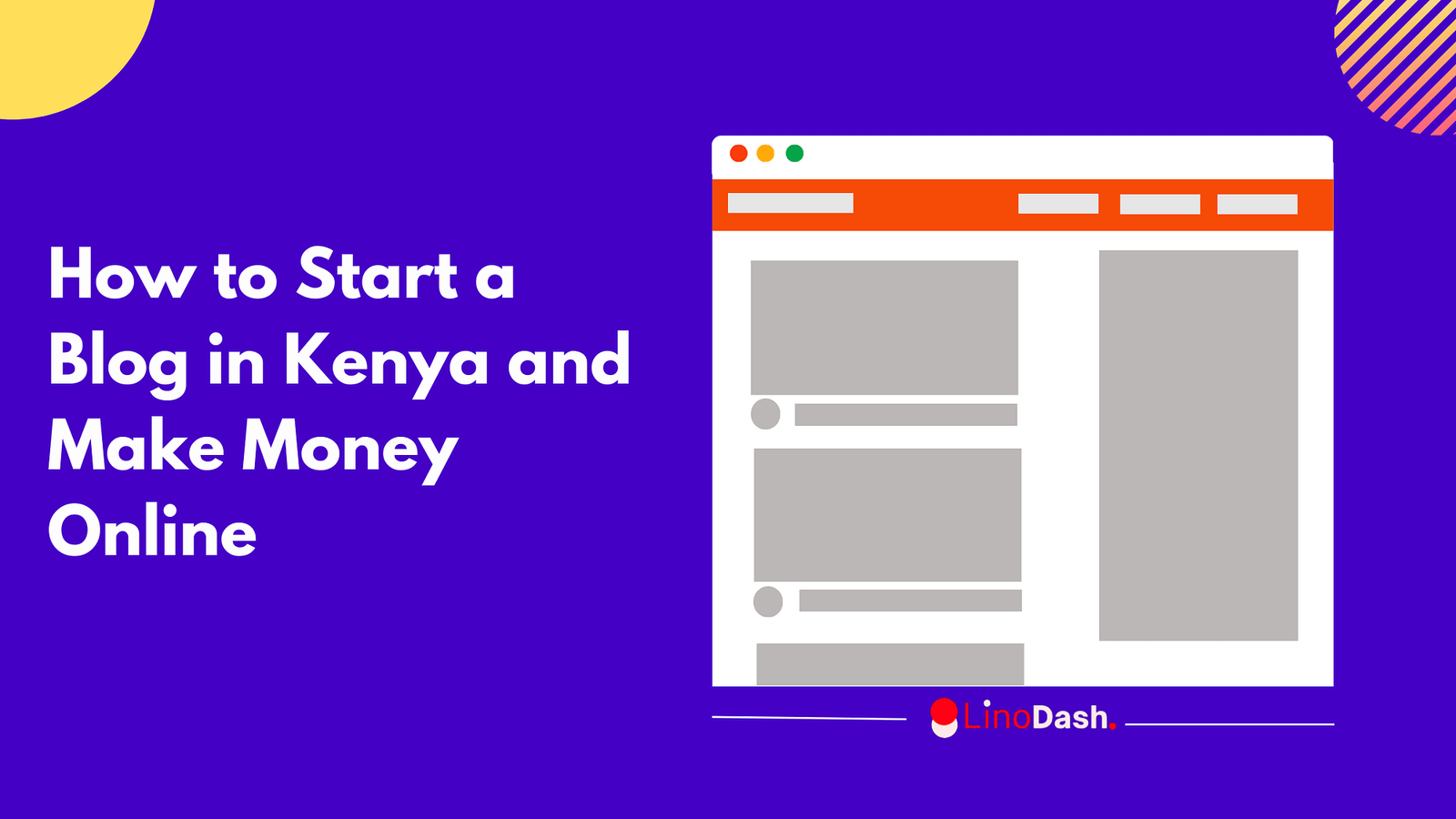So you’ve got a burning desire to start a blog in Kenya, but you’re not quite sure where to begin? Well, you’re in luck! This article is here to guide you through the process step by step, ensuring that you’re equipped with all the knowledge and tools you need to embark on your blogging journey. Whether you want to share your passion for travel, provide valuable tips and insights, or simply connect with others, starting a blog in Kenya is an exciting opportunity waiting for you to seize. Follow along as we break down the process and offer you valuable tips to help you make your mark in the blogging world.

This image is property of i.ytimg.com.
Choose a Blogging Platform
Decide on a blogging platform
When starting a blog in Kenya, the first step is to decide on a suitable blogging platform. There are several popular options available, each with its own set of features and benefits. Some of the most widely used platforms include WordPress, Blogger, and Wix. Take the time to research and consider the strengths and weaknesses of each platform before making a decision.
Consider the technical requirements
Before choosing a blogging platform, it is important to consider the technical requirements involved. Some platforms might require more technical expertise and coding knowledge, while others may offer a more user-friendly interface. Assess your own technical skills and choose a platform that aligns with your abilities. Additionally, consider the scalability and potential for growth of your blog, as some platforms may be better suited for long-term success.
Evaluate the features and customization options
Another important factor to consider when choosing a blogging platform is the available features and customization options. Look for platforms that offer a wide range of themes, plugins, and widgets that can enhance the visual appeal and functionality of your blog. It is also worth considering whether the platform supports multiple authors, comment moderation, and other features that facilitate reader engagement. Take the time to explore and compare the features of different platforms to find one that best suits your needs.
Register a Domain
Choose a domain name
Once you have decided on a blogging platform, the next step is to register a domain name for your blog. A domain is the web address that users will use to access your blog (e.g., www.yourblogname.com). Choose a domain name that is memorable, easy to spell, and relevant to the content of your blog. Consider incorporating keywords that reflect the topics you plan to write about, as this can help improve your blog’s visibility in search engine results.
Check for domain availability
After choosing a domain name, it is essential to check its availability. Thankfully, there are numerous domain name registrars that allow you to search for the availability of your desired domain. Simply enter your chosen domain name into their search bar, and they will inform you whether or not it is available. Be prepared with alternative domain name options in case your first choice is already taken.
Purchase a domain
Once you have confirmed the availability of your chosen domain name, it is time to purchase it. Most domain name registrars offer a straightforward purchasing process, allowing you to register your domain for a specific duration (e.g., one year, two years, etc.). Compare prices and consider any additional services or features offered by different registrars before making your purchase.

This image is property of bizkenya.co.ke.
Set Up Hosting
Select a hosting provider
After registering a domain, the next step is to select a hosting provider. A web hosting provider will store your blog’s files and make them accessible to users when they visit your domain. There are many hosting providers available, each with its own pricing plans, storage capabilities, and customer support. Consider factors such as uptime guarantees, server performance, and scalability when choosing a hosting provider that suits your needs.
Choose an appropriate hosting plan
When selecting a hosting plan, consider the specific requirements of your blog. If you are just starting out and expecting low traffic, a shared hosting plan may be sufficient. However, if you anticipate high traffic volumes or plan to have multiple websites, a dedicated or VPS (Virtual Private Server) hosting plan may be more suitable. Take into account your budget and the growth potential of your blog when choosing an appropriate hosting plan.
Set up hosting for your blog
Once you have chosen a hosting provider and plan, it is time to set up hosting for your blog. Most hosting providers offer an easy-to-use control panel or dashboard that allows you to manage your website. Follow the hosting provider’s instructions to link your domain to your hosting account and upload any necessary files. It is also important to set up regular backups to ensure the security and integrity of your blog’s data.
Install and Configure CMS
Choose a content management system (CMS)
A content management system (CMS) is essential for managing and organizing the content on your blog. Popular CMS options include WordPress, Joomla, and Drupal. Consider the ease of use, available plugins and themes, and community support when choosing a CMS. WordPress is often recommended for its user-friendly interface and extensive customization options, making it an ideal choice for beginners.
Install the CMS on your hosting server
Once you have chosen a CMS, you will need to install it on your hosting server. Most hosting providers offer one-click installations for popular CMS platforms, making the process quick and easy. Simply follow the instructions provided by your hosting provider to install the CMS of your choice. Take note of any login credentials or setup details that are required during the installation process.
Configure the CMS settings
After successfully installing the CMS, it is important to configure the settings to optimize your blog’s performance and security. Set up basic information such as the blog title, tagline, and permalink structure. Explore the CMS settings to customize the appearance and functionality of your blog. Familiarize yourself with the different menus and options available in the CMS to make the most of its features.

This image is property of i.ytimg.com.
Select a Theme
Browse for suitable blog themes
Once you have installed and configured your CMS, it is time to select a theme for your blog. The theme determines the overall design, layout, and visual appearance of your blog. Most CMS platforms offer a wide range of free and premium themes to choose from. Browse through the available themes and look for one that aligns with your blog’s niche or topic, as well as your personal preferences.
Consider the design, layout, and responsiveness
When selecting a theme for your blog, it is important to consider the design, layout, and responsiveness of the theme. Choose a design that reflects the tone and purpose of your blog, whether it is professional, artistic, or minimalist. Consider the layout options available and ensure that the theme is responsive, meaning it adjusts well to different screen sizes and devices. A responsive theme is crucial for providing a seamless user experience.
Customize the chosen theme
After selecting a theme, take the time to customize it to make it unique to your blog. Most themes offer customization options such as color schemes, font styles, and widget placements. Make sure to add your blog’s logo or branding elements to create a cohesive look. Experiment with different customization settings until you are satisfied with the overall appearance of your blog.
Create Engaging Content
Identify your target audience
To create engaging content, it is crucial to identify your blog’s target audience. Consider the demographic characteristics, interests, and needs of your potential readers. This will help you tailor your content to their preferences, ensuring that it resonates with them and keeps them coming back for more. Conduct market research or engage in conversations with your target audience to gain insights into their preferences and pain points.
Research and plan your blog topics
Once you have identified your target audience, research and plan your blog topics accordingly. Use keyword research tools to discover popular topics within your niche and understand what people are searching for. This will help you generate ideas for blog posts that are relevant, timely, and valuable. Create a content calendar or plan to organize your ideas and ensure a consistent flow of fresh content.
Write compelling and valuable content
When writing blog posts, focus on creating compelling and valuable content that engages your readers. Pay attention to your writing style, ensuring it is clear, concise, and easy to understand. Use storytelling techniques, personal anecdotes, or expert insights to capture your readers’ attention. Incorporate relevant images, videos, or infographics to enhance the visual appeal of your content. Ultimately, aim to provide value to your readers and address their pain points or interests.

This image is property of mljk55wvixnl.i.optimole.com.
Optimize for Search Engines
Perform keyword research
To increase the visibility of your blog in search engine results, it is important to perform keyword research. Keyword research involves identifying the specific words or phrases that people use when searching for information related to your blog’s content. Use keyword research tools to discover high-ranking keywords and incorporate them strategically into your blog posts. This will help search engines understand the relevance of your content and improve your chances of ranking higher in search results.
Optimize your blog posts with relevant keywords
Once you have identified relevant keywords, optimize your blog posts by incorporating them naturally throughout your content. Place keywords in your blog post titles, headings, meta descriptions, and within the body of your text. However, it is important to strike a balance and avoid keyword stuffing, as this can negatively impact the readability and user experience of your blog. Optimize your images by adding descriptive alt tags and ensure fast loading times for improved search engine optimization (SEO).
Improve website speed and user experience
Search engines prioritize websites that provide a positive user experience, including fast loading times and easy navigation. Optimize your blog’s speed by compressing images, minimizing code, and using caching techniques. Choose a responsive theme that adjusts well to different devices and screen sizes. Make sure your blog is easy to navigate, with clear menus and intuitive layout. Aim to provide a seamless and enjoyable browsing experience for your readers.
Promote Your Blog
Utilize social media platforms
Promoting your blog through social media platforms is an effective way to reach a wider audience. Create accounts on popular social media platforms such as Facebook, Twitter, Instagram, or LinkedIn. Share your blog posts regularly, engage with your followers, and participate in relevant conversations or trending topics. Utilize social media management tools to schedule posts in advance and optimize your social media presence.
Engage with online communities and forums
Engaging with online communities and forums is a valuable method of promoting your blog and establishing yourself as an authority in your niche. Find relevant communities or forums where your target audience gathers and participate in discussions. Provide helpful insights, answer questions, and share your blog posts when appropriate. Building meaningful connections within these communities can lead to increased website traffic and a growing reader base.
Collaborate with other bloggers or influencers
Collaborating with other bloggers or influencers can help expand your blog’s reach and attract new readers. Look for bloggers or influencers in your niche with a similar target audience and propose collaboration opportunities. This could involve guest posting on each other’s blogs, participating in joint giveaways or challenges, or conducting interviews or podcasts together. Leveraging each other’s audiences can create a win-win situation and increase your blog’s visibility.

This image is property of i.ytimg.com.
Monetize Your Blog
Explore different monetization options
Once your blog has gained traction and built a loyal readership, you can start exploring different monetization options. Consider various methods such as display advertising, sponsored content, affiliate marketing, or selling products/services directly. Research industry standards, consider the preferences of your target audience, and choose monetization methods that align with your blog’s content and values.
Advertise through display ads or sponsored content
One common monetization method is through display advertising and sponsored content. You can join ad networks such as Google AdSense to display relevant ads on your blog. Alternatively, you can collaborate with brands to create sponsored content that promotes their products or services. Be transparent with your readers about sponsored content and ensure that it aligns with the interests and values of your audience.
Consider affiliate marketing or selling products/services
Affiliate marketing involves promoting products or services of other companies and earning a commission for each sale made through your referral. Look for affiliate programs within your niche and choose products or services that are relevant and valuable to your readers. Another option is to create and sell your own products or services. This could include digital products, online courses, consultations, or physical merchandise. Ensure that your offerings align with your blog’s brand and cater to the needs of your audience.
Build a Loyal Readership
Interact with your audience through comments and feedback
Building a loyal readership involves fostering a sense of community and engagement with your audience. Encourage your readers to leave comments and provide feedback on your blog posts. Respond to their comments, answer their questions, and address their concerns. This helps create a connection with your readers, making them feel heard and valued. Regularly check for comments and engage in meaningful conversations to build a loyal readership.
Regularly update your blog with fresh content
Consistency is key when it comes to building a loyal readership. Regularly update your blog with fresh, high-quality content to keep your readers engaged and coming back for more. Create a content schedule or editorial calendar to stay organized and ensure a steady flow of new posts. Be consistent with your posting frequency and provide a mix of long-form articles, shorter informative pieces, and other types of content to cater to different reader preferences.
Encourage newsletter subscriptions
Building an email list through newsletter subscriptions is an effective way to keep your readers engaged and informed. Offer a newsletter subscription option on your blog and encourage your readers to sign up. Provide exclusive content, updates, or special offers to incentivize subscriptions. Send regular newsletters to your subscribers with highlights from your blog, curated content, or exclusive insights. This direct communication channel can help build a loyal readership and foster a deeper connection with your audience.
Starting a blog in Kenya is an exciting venture that requires careful planning and execution. By following the steps outlined in this article, you can choose a suitable blogging platform, register a domain, set up hosting, install and configure a CMS, select a theme, create engaging content, optimize for search engines, promote your blog, monetize your efforts, and build a loyal readership. Remember to continuously evaluate and adapt your blogging strategies to meet the ever-evolving needs and preferences of your audience. Happy blogging!


